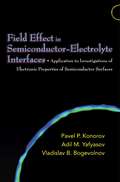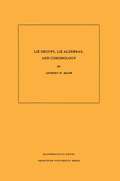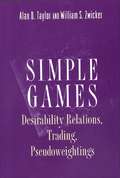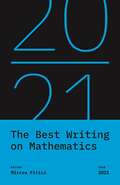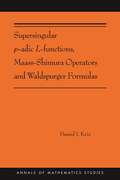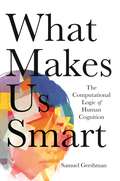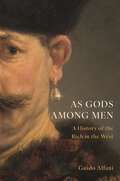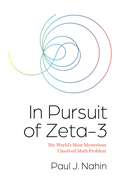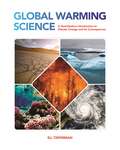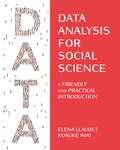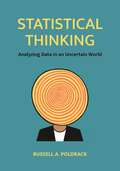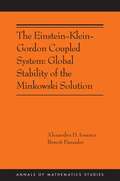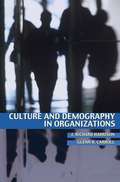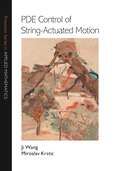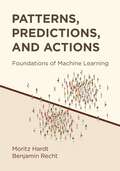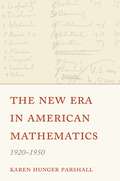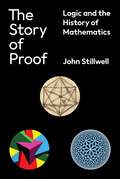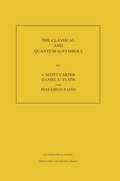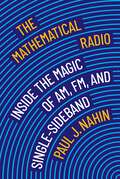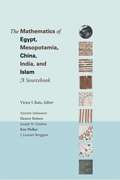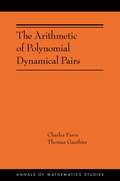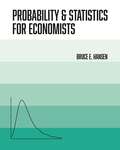- Table View
- List View
Field Effect in Semiconductor-Electrolyte Interfaces: Application to Investigations of Electronic Properties of Semiconductor Surfaces
by Pavel P. Konorov Adil M. Yafyasov Vladislav B. BogevolnovThis book presents a state-of-the-art understanding of semiconductor-electrolyte interfaces. It provides a detailed study of semiconductor-electrolyte interfacial effects, focusing on the physical and electrochemical foundations that affect surface charge, capacitance, conductance, quantum effects, and other properties, both from the point of view of theoretical modeling and metrology. The wet-dry interface, where solid-state devices may be in contact with electrolyte solutions, is of growing interest and importance. This is because such interfaces will be a key part of hydrogen energy and solar cells, and of sensors that would have wide applications in medicine, genomics, environmental science, and bioterrorism prevention. The field effect presented here by Pavel Konorov, Adil Yafyasov, and Vladislav Bogevolnov is a new method, one that allows investigation of the physical properties of semiconductor and superconductor surfaces. Before the development of this method, it was impossible to test these surfaces at room temperature. The behavior of electrodes in electrolytes under such realistic conduction conditions has been a major problem for the technical realization of systems that perform measurements in wet environments. This book also describes some material properties that were unknown before the development of the field effect method. This book will be of great interest to students and engineers working in semiconductor surface physics, electrochemistry, and micro- and nanoelectronics.
Lie Groups, Lie Algebras, and Cohomology. (Mathematical Notes #108)
by Anthony W. KnappThis book starts with the elementary theory of Lie groups of matrices and arrives at the definition, elementary properties, and first applications of cohomological induction, which is a recently discovered algebraic construction of group representations. Along the way it develops the computational techniques that are so important in handling Lie groups. The book is based on a one-semester course given at the State University of New York, Stony Brook in fall, 1986 to an audience having little or no background in Lie groups but interested in seeing connections among algebra, geometry, and Lie theory. These notes develop what is needed beyond a first graduate course in algebra in order to appreciate cohomological induction and to see its first consequences. Along the way one is able to study homological algebra with a significant application in mind; consequently one sees just what results in that subject are fundamental and what results are minor.
Simple Games: Desirability Relations, Trading, Pseudoweightings
by Alan D. Taylor William S. ZwickerSimple games are mathematical structures inspired by voting systems in which a single alternative, such as a bill, is pitted against the status quo. The first in-depth mathematical study of the subject as a coherent subfield of finite combinatorics--one with its own organized body of techniques and results--this book blends new theorems with some of the striking results from threshold logic, making all of it accessible to game theorists. Introductory material receives a fresh treatment, with an emphasis on Boolean subgames and the Rudin-Keisler order as unifying concepts. Advanced material focuses on the surprisingly wide variety of properties related to the weightedness of a game. A desirability relation orders the individuals or coalitions of a game according to their influence in the corresponding voting system. As Taylor and Zwicker show, acyclicity of such a relation approximates weightedness--the more sensitive the relation, the closer the approximation. A trade is an exchange of players among coalitions, and robustness under such trades is equivalent to weightedness of the game. Robustness under trades that fit some restrictive exchange pattern typically characterizes a wider class of simple games--for example, games for which some particular desirability order is acyclic. Finally, one can often describe these wider classes of simple games by weakening the total additivity of a weighting to obtain what is called a pseudoweighting. In providing such uniform explanations for many of the structural properties of simple games, this book showcases numerous new techniques and results.
The Best Writing on Mathematics 2021 (The Best Writing on Mathematics #20)
by Mircea PiticiThe year’s finest mathematical writing from around the worldThis annual anthology brings together the year’s finest mathematics writing from around the world—and you don’t need to be a mathematician to enjoy the pieces collected here. These essays—from leading names and fresh new voices—delve into the history, philosophy, teaching, and everyday aspects of math, offering surprising insights into its nature, meaning, and practice, and taking readers behind the scenes of today’s hottest mathematical debates.Here, Viktor Blåsjö gives a brief history of “lockdown mathematics”; Yelda Nasifoglu decodes the politics of a seventeenth-century play in which the characters are geometric shapes; and Andrew Lewis-Pye explains the basic algorithmic rules and computational procedures behind cryptocurrencies. In other essays, Terence Tao candidly recalls the adventures and misadventures of growing up to become a leading mathematician; Natalie Wolchover shows how old math gives new clues about whether time really flows; and David Hand discusses the problem of “dark data”—information that is missing or ignored. And there is much, much more.
The Best Writing on Mathematics 2021 (The Best Writing on Mathematics #20)
by Mircea PiticiThe year’s finest mathematical writing from around the worldThis annual anthology brings together the year’s finest mathematics writing from around the world—and you don’t need to be a mathematician to enjoy the pieces collected here. These essays—from leading names and fresh new voices—delve into the history, philosophy, teaching, and everyday aspects of math, offering surprising insights into its nature, meaning, and practice, and taking readers behind the scenes of today’s hottest mathematical debates.Here, Viktor Blåsjö gives a brief history of “lockdown mathematics”; Yelda Nasifoglu decodes the politics of a seventeenth-century play in which the characters are geometric shapes; and Andrew Lewis-Pye explains the basic algorithmic rules and computational procedures behind cryptocurrencies. In other essays, Terence Tao candidly recalls the adventures and misadventures of growing up to become a leading mathematician; Natalie Wolchover shows how old math gives new clues about whether time really flows; and David Hand discusses the problem of “dark data”—information that is missing or ignored. And there is much, much more.
Supersingular p-adic L-functions, Maass-Shimura Operators and Waldspurger Formulas: (AMS-212) (Annals of Mathematics Studies #402)
by Daniel KrizA groundbreaking contribution to number theory that unifies classical and modern resultsThis book develops a new theory of p-adic modular forms on modular curves, extending Katz's classical theory to the supersingular locus. The main novelty is to move to infinite level and extend coefficients to period sheaves coming from relative p-adic Hodge theory. This makes it possible to trivialize the Hodge bundle on the infinite-level modular curve by a "canonical differential" that restricts to the Katz canonical differential on the ordinary Igusa tower. Daniel Kriz defines generalized p-adic modular forms as sections of relative period sheaves transforming under the Galois group of the modular curve by weight characters. He introduces the fundamental de Rham period, measuring the position of the Hodge filtration in relative de Rham cohomology. This period can be viewed as a counterpart to Scholze's Hodge-Tate period, and the two periods satisfy a Legendre-type relation. Using these periods, Kriz constructs splittings of the Hodge filtration on the infinite-level modular curve, defining p-adic Maass-Shimura operators that act on generalized p-adic modular forms as weight-raising operators. Through analysis of the p-adic properties of these Maass-Shimura operators, he constructs new p-adic L-functions interpolating central critical Rankin-Selberg L-values, giving analogues of the p-adic L-functions of Katz, Bertolini-Darmon-Prasanna, and Liu-Zhang-Zhang for imaginary quadratic fields in which p is inert or ramified. These p-adic L-functions yield new p-adic Waldspurger formulas at special values.
What Makes Us Smart: The Computational Logic of Human Cognition
by Samuel GershmanHow a computational framework can account for the successes and failures of human cognitionAt the heart of human intelligence rests a fundamental puzzle: How are we incredibly smart and stupid at the same time? No existing machine can match the power and flexibility of human perception, language, and reasoning. Yet, we routinely commit errors that reveal the failures of our thought processes. What Makes Us Smart makes sense of this paradox by arguing that our cognitive errors are not haphazard. Rather, they are the inevitable consequences of a brain optimized for efficient inference and decision making within the constraints of time, energy, and memory—in other words, data and resource limitations. Framing human intelligence in terms of these constraints, Samuel Gershman shows how a deeper computational logic underpins the “stupid” errors of human cognition.Embarking on a journey across psychology, neuroscience, computer science, linguistics, and economics, Gershman presents unifying principles that govern human intelligence. First, inductive bias: any system that makes inferences based on limited data must constrain its hypotheses in some way before observing data. Second, approximation bias: any system that makes inferences and decisions with limited resources must make approximations. Applying these principles to a range of computational errors made by humans, Gershman demonstrates that intelligent systems designed to meet these constraints yield characteristically human errors.Examining how humans make intelligent and maladaptive decisions, What Makes Us Smart delves into the successes and failures of cognition.
What Makes Us Smart: The Computational Logic of Human Cognition
by Samuel GershmanHow a computational framework can account for the successes and failures of human cognitionAt the heart of human intelligence rests a fundamental puzzle: How are we incredibly smart and stupid at the same time? No existing machine can match the power and flexibility of human perception, language, and reasoning. Yet, we routinely commit errors that reveal the failures of our thought processes. What Makes Us Smart makes sense of this paradox by arguing that our cognitive errors are not haphazard. Rather, they are the inevitable consequences of a brain optimized for efficient inference and decision making within the constraints of time, energy, and memory—in other words, data and resource limitations. Framing human intelligence in terms of these constraints, Samuel Gershman shows how a deeper computational logic underpins the “stupid” errors of human cognition.Embarking on a journey across psychology, neuroscience, computer science, linguistics, and economics, Gershman presents unifying principles that govern human intelligence. First, inductive bias: any system that makes inferences based on limited data must constrain its hypotheses in some way before observing data. Second, approximation bias: any system that makes inferences and decisions with limited resources must make approximations. Applying these principles to a range of computational errors made by humans, Gershman demonstrates that intelligent systems designed to meet these constraints yield characteristically human errors.Examining how humans make intelligent and maladaptive decisions, What Makes Us Smart delves into the successes and failures of cognition.
As Gods Among Men: A History of the Rich in the West
by Guido AlfaniHow the rich and the super-rich throughout Western history accumulated their wealth, behaved (or misbehaved) and helped (or didn&’t help) their communities in times of crisis The rich have always fascinated, sometimes in problematic ways. Medieval thinkers feared that the super-rich would act 'as gods among men&’; much more recently Thomas Piketty made wealth central to discussions of inequality. In this book, Guido Alfani offers a history of the rich and super-rich in the West, examining who they were, how they accumulated their wealth and what role they played in society. Covering the last thousand years, with frequent incursions into antiquity, and integrating recent research on economic inequality, Alfani finds—despite the different paths to wealth in different eras—fundamental continuities in the behaviour of the rich and public attitudes towards wealth across Western history. His account offers a novel perspective on current debates about wealth and income disparity.Alfani argues that the position of the rich and super-rich in Western society has always been intrinsically fragile; their very presence has inspired social unease. In the Middle Ages, an excessive accumulation of wealth was considered sinful; the rich were expected not to appear to be wealthy. Eventually, the rich were deemed useful when they used their wealth to help their communities in times of crisis. Yet in the twenty-first century, Alfani points out, the rich and the super-rich—their wealth largely preserved through the Great Recession and COVID-19—have been exceptionally reluctant to contribute to the common good in times of crisis, rejecting even such stopgap measures as temporary tax increases. History suggests that this is a troubling development—for the rich, and for everyone else.
As Gods Among Men: A History of the Rich in the West
by Guido AlfaniHow the rich and the super-rich throughout Western history accumulated their wealth, behaved (or misbehaved) and helped (or didn&’t help) their communities in times of crisis The rich have always fascinated, sometimes in problematic ways. Medieval thinkers feared that the super-rich would act 'as gods among men&’; much more recently Thomas Piketty made wealth central to discussions of inequality. In this book, Guido Alfani offers a history of the rich and super-rich in the West, examining who they were, how they accumulated their wealth and what role they played in society. Covering the last thousand years, with frequent incursions into antiquity, and integrating recent research on economic inequality, Alfani finds—despite the different paths to wealth in different eras—fundamental continuities in the behaviour of the rich and public attitudes towards wealth across Western history. His account offers a novel perspective on current debates about wealth and income disparity.Alfani argues that the position of the rich and super-rich in Western society has always been intrinsically fragile; their very presence has inspired social unease. In the Middle Ages, an excessive accumulation of wealth was considered sinful; the rich were expected not to appear to be wealthy. Eventually, the rich were deemed useful when they used their wealth to help their communities in times of crisis. Yet in the twenty-first century, Alfani points out, the rich and the super-rich—their wealth largely preserved through the Great Recession and COVID-19—have been exceptionally reluctant to contribute to the common good in times of crisis, rejecting even such stopgap measures as temporary tax increases. History suggests that this is a troubling development—for the rich, and for everyone else.
In Pursuit of Zeta-3: The World's Most Mysterious Unsolved Math Problem
by Paul J. NahinAn engrossing look at the history and importance of a centuries-old but still unanswered math problemFor centuries, mathematicians the world over have tried, and failed, to solve the zeta-3 problem. Math genius Leonhard Euler attempted it in the 1700s and came up short. The straightforward puzzle considers if there exists a simple symbolic formula for the following: 1+(1/2)^3+(1/3)^3+(1/4)^3+. . . . But why is this issue—the sum of the reciprocals of the positive integers cubed—so important? With In Pursuit of Zeta-3, popular math writer Paul Nahin investigates the history and significance of this mathematical conundrum.Drawing on detailed examples, historical anecdotes, and even occasionally poetry, Nahin sheds light on the richness of the nature of zeta-3. He shows its intimate connections to the Riemann hypothesis, another mathematical mystery that has stumped mathematicians for nearly two centuries. He looks at its links with Euler’s achievements and explores the modern research area of Euler sums, where zeta-3 occurs frequently. An exact solution to the zeta-3 question wouldn’t simply satisfy pure mathematical interest: it would have critical ramifications for applications in physics and engineering, such as quantum electrodynamics. Challenge problems with detailed solutions and MATLAB code are included at the end of each of the book’s sections.Detailing the trials and tribulations of mathematicians who have approached one of the field’s great unsolved riddles, In Pursuit of Zeta-3 will tantalize curious math enthusiasts everywhere.
Global Warming Science: A Quantitative Introduction to Climate Change and Its Consequences
by Eli TzipermanA quantitative, broad, hands-on introduction to the cutting-edge science of global warmingThis textbook introduces undergraduates to the concepts and methods of global warming science, covering topics that they encounter in the news, ranging from the greenhouse effect and warming to ocean acidification, hurricanes, extreme precipitation, droughts, heat waves, forest fires, the cryosphere, and more. This book explains each of the issues based on basic statistical analysis, simple ordinary differential equations, or elementary chemical reactions. Each chapter explains the mechanisms behind an observed or anticipated change in the climate system and demonstrates the tools used to understand and predict them. Proven in the classroom, Global Warming Science also includes “workshops” with every chapter, each based on a Jupyter Python notebook and an accompanying small data set, with supplementary online materials and slides for instructors. The workshop can be used as an interactive learning element in class and as a homework assignment.Provides a clear, broad, quantitative yet accessible approach to the science of global warmingEngages students in the analysis of climate data and models, examining predictions, and dealing with uncertaintyFeatures workshops with each chapter that enhance learning through hands-on engagementComes with supplementary online slides, code, and data filesRequires only elementary undergraduate-level calculus and basic statistics; no prior coursework in science is assumedSolutions manual available (only to instructors)
Data Analysis for Social Science: A Friendly and Practical Introduction
by Elena Llaudet Kosuke ImaiAn ideal textbook for an introductory course on quantitative methods for social scientists—assumes no prior knowledge of statistics or codingData Analysis for Social Science provides a friendly introduction to the statistical concepts and programming skills needed to conduct and evaluate social scientific studies. Using plain language and assuming no prior knowledge of statistics and coding, the book provides a step-by-step guide to analyzing real-world data with the statistical program R for the purpose of answering a wide range of substantive social science questions. It teaches not only how to perform the analyses but also how to interpret results and identify strengths and limitations. This one-of-a-kind textbook includes supplemental materials to accommodate students with minimal knowledge of math and clearly identifies sections with more advanced material so that readers can skip them if they so choose.Analyzes real-world data using the powerful, open-sourced statistical program R, which is free for everyone to useTeaches how to measure, predict, and explain quantities of interest based on dataShows how to infer population characteristics using survey research, predict outcomes using linear models, and estimate causal effects with and without randomized experimentsAssumes no prior knowledge of statistics or codingSpecifically designed to accommodate students with a variety of math backgroundsProvides cheatsheets of statistical concepts and R codeSupporting materials available online, including real-world datasets and the code to analyze them, plus—for instructor use—sample syllabi, sample lecture slides, additional datasets, and additional exercises with solutionsLooking for a more advanced introduction? Consider Quantitative Social Science by Kosuke Imai. In addition to covering the material in Data Analysis for Social Science, it teaches diffs-in-diffs models, heterogeneous effects, text analysis, and regression discontinuity designs, among other things.
Statistical Thinking: Analyzing Data in an Uncertain World
by Russell PoldrackAn essential introduction to statistics for students of psychology and the social sciencesStatistical thinking is increasingly essential to understanding our complex world and making informed decisions based on uncertain data. This incisive undergraduate textbook introduces students to the main ideas of statistics in a way that focuses on deep comprehension rather than rote application or mathematical immersion. The presentation of statistical concepts is thoroughly modern, sharing cutting-edge ideas from the fields of machine learning and data science that help students effectively use statistical methods to ask questions about data. Statistical Thinking provides the tools to describe complex patterns that emerge from data and to make accurate predictions and decisions based on data.Introduces statistics from a uniquely modern standpoint, helping students to use the basic ideas of statistics to analyze real dataPresents a model of statistics that ties together a broad range of statistical techniques that can be used to answer many different kinds of questionsExplains how to use statistics to generate reproducible findings and avoid common mistakes in statistical practiceIncludes a wealth of examples using real-world dataAccompanied by computer code in R and in Python—freely available online—that enables students to see how each example is generated and to code their own analyses
The Einstein-Klein-Gordon Coupled System: Global Stability of the Minkowski Solution: (AMS-213) (Annals of Mathematics Studies #406)
by Alexandru D. Ionescu Benoît PausaderA definitive proof of global nonlinear stability of Minkowski space-time as a solution of the Einstein-Klein-Gordon equationsThis book provides a definitive proof of global nonlinear stability of Minkowski space-time as a solution of the Einstein-Klein-Gordon equations of general relativity. Along the way, a novel robust analytical framework is developed, which extends to more general matter models. Alexandru Ionescu and Benoît Pausader prove global regularity at an appropriate level of generality of the initial data, and then prove several important asymptotic properties of the resulting space-time, such as future geodesic completeness, peeling estimates of the Riemann curvature tensor, conservation laws for the ADM tensor, and Bondi energy identities and inequalities.The book is self-contained, providing complete proofs and precise statements, which develop a refined theory for solutions of quasilinear Klein-Gordon and wave equations, including novel linear and bilinear estimates. Only mild decay assumptions are made on the scalar field and the initial metric is allowed to have nonisotropic decay consistent with the positive mass theorem. The framework incorporates analysis both in physical and Fourier space, and is compatible with previous results on other physical models such as water waves and plasma physics.
Culture and Demography in Organizations
by Glenn R. Carroll J. Richard HarrisonHow do corporations and other organizations maintain and transmit their cultures over time? Culture and Demography in Organizations offers the most reliable and comprehensive answer to this complex question to date. The first book on the subject to ground its analysis in mathematical tools and computer simulation, it goes beyond standard approaches, which focus on socialization within organizations, by explicitly considering the effects of demographic processes of entry, exit, and organizational growth. J. Richard Harrison and Glenn R. Carroll base their analysis on a formal model with three components: hiring, socialization, and employee turnover. In exploring the model's implications through computer simulation methods, the authors cover topics such as organizational growth and decline, top management teams, organizational influence networks, terrorist organizations, cultural integration following mergers, and organizational failure. For each topic, they identify the conditions influencing cultural transmission. In general, they find that demographic processes play a central role in influencing organizational culture and that studying these processes leads to some surprising insights unavailable when considering socialization alone. This book, which also serves as an ideal introduction to the increasingly popular use of computer simulation, will be an indispensable resource for scholars and students of organization theory and behavior, cultural studies, strategic management, sociology, economics, and social simulation.
PDE Control of String-Actuated Motion (Princeton Series in Applied Mathematics #76)
by Ji Wang Miroslav KrsticNew adaptive and event-triggered control designs with concrete applications in undersea construction, offshore drilling, and cable elevatorsControl applications in undersea construction, cable elevators, and offshore drilling present major methodological challenges because they involve PDE systems (cables and drillstrings) of time-varying length, coupled with ODE systems (the attached loads or tools) that usually have unknown parameters and unmeasured states. In PDE Control of String-Actuated Motion, Ji Wang and Miroslav Krstic develop control algorithms for these complex PDE-ODE systems evolving on time-varying domains.Motivated by physical systems, the book’s algorithms are designed to operate, with rigorous mathematical guarantees, in the presence of real-world challenges, such as unknown parameters, unmeasured distributed states, environmental disturbances, delays, and event-triggered implementations. The book leverages the power of the PDE backstepping approach and expands its scope in many directions.Filled with theoretical innovations and comprehensive in its coverage, PDE Control of String-Actuated Motion provides new design tools and mathematical techniques with far-reaching potential in adaptive control, delay systems, and event-triggered control.
Patterns, Predictions, and Actions: Foundations of Machine Learning
by Moritz Hardt Benjamin RechtAn authoritative, up-to-date graduate textbook on machine learning that highlights its historical context and societal impactsPatterns, Predictions, and Actions introduces graduate students to the essentials of machine learning while offering invaluable perspective on its history and social implications. Beginning with the foundations of decision making, Moritz Hardt and Benjamin Recht explain how representation, optimization, and generalization are the constituents of supervised learning. They go on to provide self-contained discussions of causality, the practice of causal inference, sequential decision making, and reinforcement learning, equipping readers with the concepts and tools they need to assess the consequences that may arise from acting on statistical decisions.Provides a modern introduction to machine learning, showing how data patterns support predictions and consequential actionsPays special attention to societal impacts and fairness in decision makingTraces the development of machine learning from its origins to todayFeatures a novel chapter on machine learning benchmarks and datasetsInvites readers from all backgrounds, requiring some experience with probability, calculus, and linear algebraAn essential textbook for students and a guide for researchers
The New Era in American Mathematics, 1920–1950
by Karen Hunger ParshallA meticulously researched history on the development of American mathematics in the three decades following World War IAs the Roaring Twenties lurched into the Great Depression, to be followed by the scourge of Nazi Germany and World War II, American mathematicians pursued their research, positioned themselves collectively within American science, and rose to global mathematical hegemony. How did they do it? The New Era in American Mathematics, 1920–1950 explores the institutional, financial, social, and political forces that shaped and supported this community in the first half of the twentieth century. In doing so, Karen Hunger Parshall debunks the widely held view that American mathematics only thrived after European émigrés fled to the shores of the United States.Drawing from extensive archival and primary-source research, Parshall uncovers the key players in American mathematics who worked together to effect change and she looks at their research output over the course of three decades. She highlights the educational, professional, philanthropic, and governmental entities that bolstered progress. And she uncovers the strategies implemented by American mathematicians in their quest for the advancement of knowledge. Throughout, she considers how geopolitical circumstances shifted the course of the discipline.Examining how the American mathematical community asserted itself on the international stage, The New Era in American Mathematics, 1920–1950 shows the way one nation became the focal point for the field.
The Story of Proof: Logic and the History of Mathematics
by John StillwellHow the concept of proof has enabled the creation of mathematical knowledgeThe Story of Proof investigates the evolution of the concept of proof—one of the most significant and defining features of mathematical thought—through critical episodes in its history. From the Pythagorean theorem to modern times, and across all major mathematical disciplines, John Stillwell demonstrates that proof is a mathematically vital concept, inspiring innovation and playing a critical role in generating knowledge.Stillwell begins with Euclid and his influence on the development of geometry and its methods of proof, followed by algebra, which began as a self-contained discipline but later came to rival geometry in its mathematical impact. In particular, the infinite processes of calculus were at first viewed as “infinitesimal algebra,” and calculus became an arena for algebraic, computational proofs rather than axiomatic proofs in the style of Euclid. Stillwell proceeds to the areas of number theory, non-Euclidean geometry, topology, and logic, and peers into the deep chasm between natural number arithmetic and the real numbers. In its depths, Cantor, Gödel, Turing, and others found that the concept of proof is ultimately part of arithmetic. This startling fact imposes fundamental limits on what theorems can be proved and what problems can be solved.Shedding light on the workings of mathematics at its most fundamental levels, The Story of Proof offers a compelling new perspective on the field’s power and progress.
The Classical and Quantum 6j-symbols. (Mathematical Notes #109)
by J. Scott Carter Daniel E. Flath Masahico SaitoAddressing physicists and mathematicians alike, this book discusses the finite dimensional representation theory of sl(2), both classical and quantum. Covering representations of U(sl(2)), quantum sl(2), the quantum trace and color representations, and the Turaev-Viro invariant, this work is useful to graduate students and professionals. The classic subject of representations of U(sl(2)) is equivalent to the physicists' theory of quantum angular momentum. This material is developed in an elementary way using spin-networks and the Temperley-Lieb algebra to organize computations that have posed difficulties in earlier treatments of the subject. The emphasis is on the 6j-symbols and the identities among them, especially the Biedenharn-Elliott and orthogonality identities. The chapter on the quantum group Ub-3.0 qb0(sl(2)) develops the representation theory in strict analogy with the classical case, wherein the authors interpret the Kauffman bracket and the associated quantum spin-networks algebraically. The authors then explore instances where the quantum parameter q is a root of unity, which calls for a representation theory of a decidedly different flavor. The theory in this case is developed, modulo the trace zero representations, in order to arrive at a finite theory suitable for topological applications. The Turaev-Viro invariant for 3-manifolds is defined combinatorially using the theory developed in the preceding chapters. Since the background from the classical, quantum, and quantum root of unity cases has been explained thoroughly, the definition of this invariant is completely contained and justified within the text.
The Mathematical Radio: Inside the Magic of AM, FM, and Single-Sideband
by Paul J. NahinHow a modern radio works, told through mathematics, history, and selected puzzlesThe modern radio is a wonder, and behind that magic is mathematics. In The Mathematical Radio, Paul Nahin explains how radios work, deploying mathematics and historical discussion, accompanied by a steady stream of intriguing puzzles for math buffs to ponder. Beginning with oscillators and circuits, then moving on to AM, FM, and single-sideband radio, Nahin focuses on the elegant mathematics underlying radio technology rather than the engineering. He explores and explains more than a century of key developments, placing them in historical and technological context.Nahin, a prolific author of books on math for the general reader, describes in fascinating detail the mathematical underpinnings of a technology we use daily. He explains and solves, for example, Maxwell&’s equations for the electromagnetic field. Readers need only a familarity with advanced high school–level math to follow Nahin&’s mathematical discussions. Writing with the nonengineer in mind, Nahin examines topics including impulses in time and frequency, spectrum shifting at the transmitter, the superheterodyne, the physics of single-sideband radio, and FM sidebands. Chapters end with &“challenge problems&” and an appendix offers solutions, partial answers, and hints. Readers will come away with a new appreciation for the beauty of even the most useful mathematics.
The Mathematics of Egypt, Mesopotamia, China, India, and Islam: A Sourcebook
by Kim Plofker Annette Imhausen Joseph Warren Dauben J. Lennart Berggren Eleanor RobsonIn recent decades it has become obvious that mathematics has always been a worldwide activity. But this is the first book to provide a substantial collection of English translations of key mathematical texts from the five most important ancient and medieval non-Western mathematical cultures, and to put them into full historical and mathematical context. The Mathematics of Egypt, Mesopotamia, China, India, and Islam gives English readers a firsthand understanding and appreciation of these cultures' important contributions to world mathematics. The five section authors--Annette Imhausen (Egypt), Eleanor Robson (Mesopotamia), Joseph Dauben (China), Kim Plofker (India), and J. Lennart Berggren (Islam)--are experts in their fields. Each author has selected key texts and in many cases provided new translations. The authors have also written substantial section introductions that give an overview of each mathematical culture and explanatory notes that put each selection into context. This authoritative commentary allows readers to understand the sometimes unfamiliar mathematics of these civilizations and the purpose and significance of each text. Addressing a critical gap in the mathematics literature in English, this book is an essential resource for anyone with at least an undergraduate degree in mathematics who wants to learn about non-Western mathematical developments and how they helped shape and enrich world mathematics. The book is also an indispensable guide for mathematics teachers who want to use non-Western mathematical ideas in the classroom.
The Arithmetic of Polynomial Dynamical Pairs: (AMS-214) (Annals of Mathematics Studies #401)
by Charles Favre Thomas GauthierNew mathematical research in arithmetic dynamicsIn The Arithmetic of Polynomial Dynamical Pairs, Charles Favre and Thomas Gauthier present new mathematical research in the field of arithmetic dynamics. Specifically, the authors study one-dimensional algebraic families of pairs given by a polynomial with a marked point. Combining tools from arithmetic geometry and holomorphic dynamics, they prove an “unlikely intersection” statement for such pairs, thereby demonstrating strong rigidity features for them. They further describe one-dimensional families in the moduli space of polynomials containing infinitely many postcritically finite parameters, proving the dynamical André-Oort conjecture for curves in this context, originally stated by Baker and DeMarco.This is a reader-friendly invitation to a new and exciting research area that brings together sophisticated tools from many branches of mathematics.
Probability and Statistics for Economists
by Bruce HansenA comprehensive and up-to-date introduction to the mathematics that all economics students need to knowProbability theory is the quantitative language used to handle uncertainty and is the foundation of modern statistics. Probability and Statistics for Economists provides graduate and PhD students with an essential introduction to mathematical probability and statistical theory, which are the basis of the methods used in econometrics. This incisive textbook teaches fundamental concepts, emphasizes modern, real-world applications, and gives students an intuitive understanding of the mathematics that every economist needs to know.Covers probability and statistics with mathematical rigor while emphasizing intuitive explanations that are accessible to economics students of all backgroundsDiscusses random variables, parametric and multivariate distributions, sampling, the law of large numbers, central limit theory, maximum likelihood estimation, numerical optimization, hypothesis testing, and moreFeatures hundreds of exercises that enable students to learn by doingIncludes an in-depth appendix summarizing important mathematical results as well as a wealth of real-world examplesCan serve as a core textbook for a first-semester PhD course in econometrics and as a companion book to Bruce E. Hansen’s EconometricsAlso an invaluable reference for researchers and practitioners
